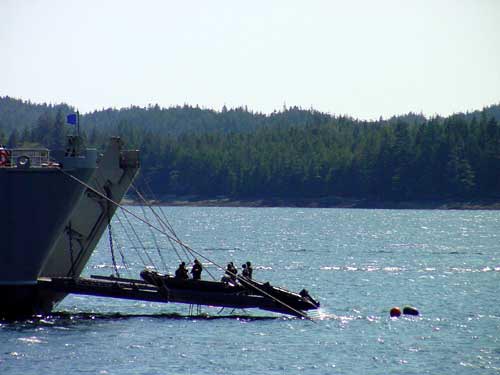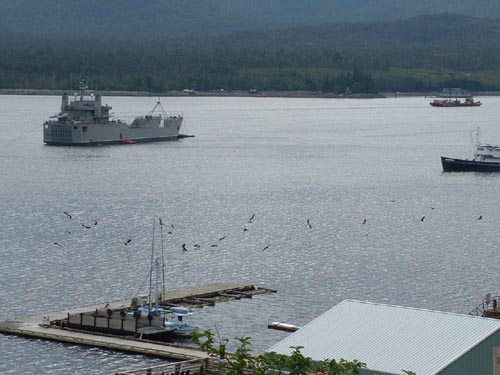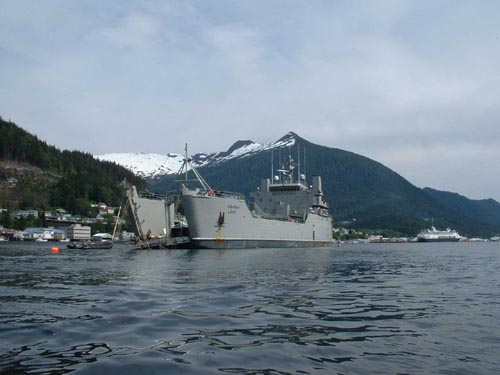 Glitter to gold still lies on ocean floor By June Allen May 30, 2003
Archived newspapers from 1954 no doubt have the story of the exact date and details of the cement barge's sinking. A relevant fact is that the sunken barge must have been just one of a great many barge-loads of cement to arrive in Ketchikan that year and the several years before. Ketchikan in 1954 was nearing the end of a construction and expansion boom not equaled before or since! Consider the concrete in the tunnel (finished that year), all the piling underpinnings of the whole Water Street and Tongass Avenue construction, paving, the new concrete high rises, the smaller buildings, and dozens of other construction jobs, not to mention the new pulp mill's construction needs. It was an exciting time!  Anchored in the Tongass Narrows over the wreck site... Photo by Gigi Pilcher - May 08, 2003 The cement barge in Tongass Narrows is (was) just one of hundreds of obstructions, artifacts and even treasures lying on Alaska's vast ocean floor. The capricious Alaska winds, waters, rocks and icebergs can - and have - caused countless marine accidents. The resultant, invisible underwater relics have also created a hankering among the adventurous to find and salvage those treasures. The cement barge lying at the bottom of Tongass Narrows didn't seem worth a salvage effort at the time of its sinking. It didn't glitter like gold. But, as the saying goes, one man's trash is another man's treasure. Someone saw the cement barge as a treasure. He was a local Alaskan, and he tried his best not all that long ago - in the late '60s and early '70s - to salvage that barge, all by himself! His name was Bill Huckins. He was an Alaskan and a diver like his father before him. His father had been among the divers in a lengthy and well-financed 1929-1934 salvage attempt on the 1901 Gold Rush wreck of the Canadian steamship Islander near Juneau. Huckins' father saw success when the largest portion of the ship was finally salvaged after years of effort. But it was eventual failure. Bill Huckins was sure he could raise that cement barge in Tongass Narrows, in time. His reasons for taking on such a huge project were other than navigational. He saw value in the submerged cargo. Huckins believed that the water had seeped only into the outer portion of the cement sacks and that the larger inside portion of the cement was still as useable as it was the day it sank. He could sell the salvaged cement. That's not such a bizarre idea! Alaskan Gold Rush pioneer and movie magnate David Gross (founder of today's Gross Theater chain) made part of his stake at Dyea in 1897 by buying from a disillusioned baker a shipment of offloaded 100-pound flour bags that had been submerged on the beach in the unexpected Dyea tides. Gross, a tailor by training, sewed new, smaller and easier to pack canvas bags into which he poured the perfectly good flour encased in the cement-like water-soaked shell. Maybe cement is like flour?  Photo by Chris Wilhelm - May 29, 2003 Bill Huckins was willing to risk it on the barge sunken in Ketchikan's shipping channel. He needed the money from the anticipated sale of the cement. He was no longer young, a short, slender man with light blue eyes and a gray brush cut. He was a quiet man and listened a whole lot more than he talked. His home at that time was at Happy Harbor near Kasaan, where he and his much younger wife and a number of small children were said to be living a sort of subsistence existence year-round. She and the children liked the lifestyle. Only the Forest Service seemed to have a problem with the family's residency in that particular spot. Bill spent his summers in Ketchikan working on raising the cement barge during the day and playing the piano in nightspots to earn a little cash. If you lived in Ketchikan in the 1960s and through the 70's, you may have seen him at the piano at your favorite watering hole. He also worked odd jobs in town but spent most of his time on the larger pursuit - raising that barge. It was his Titanic. He could be seen storing his gear on the water side of the by-then closed Smiley's cannery - a trim middle-aged man in his well worn wet suit and gray crew cut. Bill Huckins finally had to give up on the barge in the 1970s. His father hadn't given up on the sunken Islander back in the '30s, but the elder Huckins was only an employee of the salvage company. And then when the old luxury steamship was finally raised, the salvors couldn't find the pot of gold at the end of the rainbow, referred to in later documents as the anticipated 12 tons of gold! The Canadian steamship Islander, built in Scotland in 1888 and commissioned especially for the Victoria to Skagway run, was a 240-foot steel-hulled, twin screw passenger liner, called in contemporary accounts the most luxurious steamer in Alaska waters at the time. It was the favored by the wealthy but it didn't hesitate in August of 1901 to take aboard the Dawson miners and their annual gold cleanup. The miners may not have been on a social par with the wealthy tourists and sightseers aboard, but they were welcomed nonetheless. It was the custom then to store valuables, such as gold, in the purser's office midships.  Photo by Chris Wilhelm - May 30, 2003 One August 15, 1901, the southbound Islander, cruising along about 12 miles south of Juneau, sideswiped what was later reported either a submerged rock or possibly an iceberg from the Taku Glacier. The ship's bow quickly began taking on water, lifting the aft quarters out of water. It was reported that the ship drifted only for fifteen minutes or so in a strong outgoing tide before the bow made its final plunge. Forty passengers were lost, among them women and children. Plus 12 tons of gold. Salvage efforts were made the following year, but Alaska shipwrecks tend to happen in places least favored for salvage. Intermittent attempts were made later, but technology had not yet developed to a stage that would make salvage likely. Then in 1929 a new effort at salvage of the Islander was begun. A group of salvors teamed up with a professional house mover to try their luck at salvage. They decided to try to string heavy cables attached to surface ships under the sunken vessel and attached to the surface workboats. The workboats would then try to pull the lashed and secured sunken hulk to shore. They could only work during the salvage season, so the entire process, with delays and interruptions, continued until 1934 when the old ship broke the surface and was secured. The wreck was brought up from 175 feet of water. There was jubilation! Next came the huge task of mucking out the mud and debris until finally the purser's quarters were opened up. But the 12 tons of gold wasn't there! After all that time and effort, the salvage crews recovered only $75,000 in nuggets and dust. The purser's safe held a few $10 and $20 gold pieces and a soggy collection of U.S. and Canadian paper money. The bow section, the forward 60 feet of the Islander, still lay - and still apparently lies - on the ocean floor. It is assumed that the reported miner's tons of gold are still in the mail and storage room of the submerged bow. It isn't likely that it scattered. That forward section of the wreck was re-located in 1996 via side scan sonar. At present the discoverers of the bow's location and marine insurance company are plowing through the all the legal tangles and arguments of "who gets the gold" if it is ever indeed recovered. And that sunken barge in Tongass Narrows? Hopefully, once the barge is secured, would it be possible one of the U.S. Army crew to salvage one of the sacks of cement, take it topside and let us know if there is indeed salvageable cement inside it? Those of who knew and rooted for Bill Huckins back then would kind of like to know.
All rights reserved. Not to be reprinted in any form without the written permission of June Allen.
|